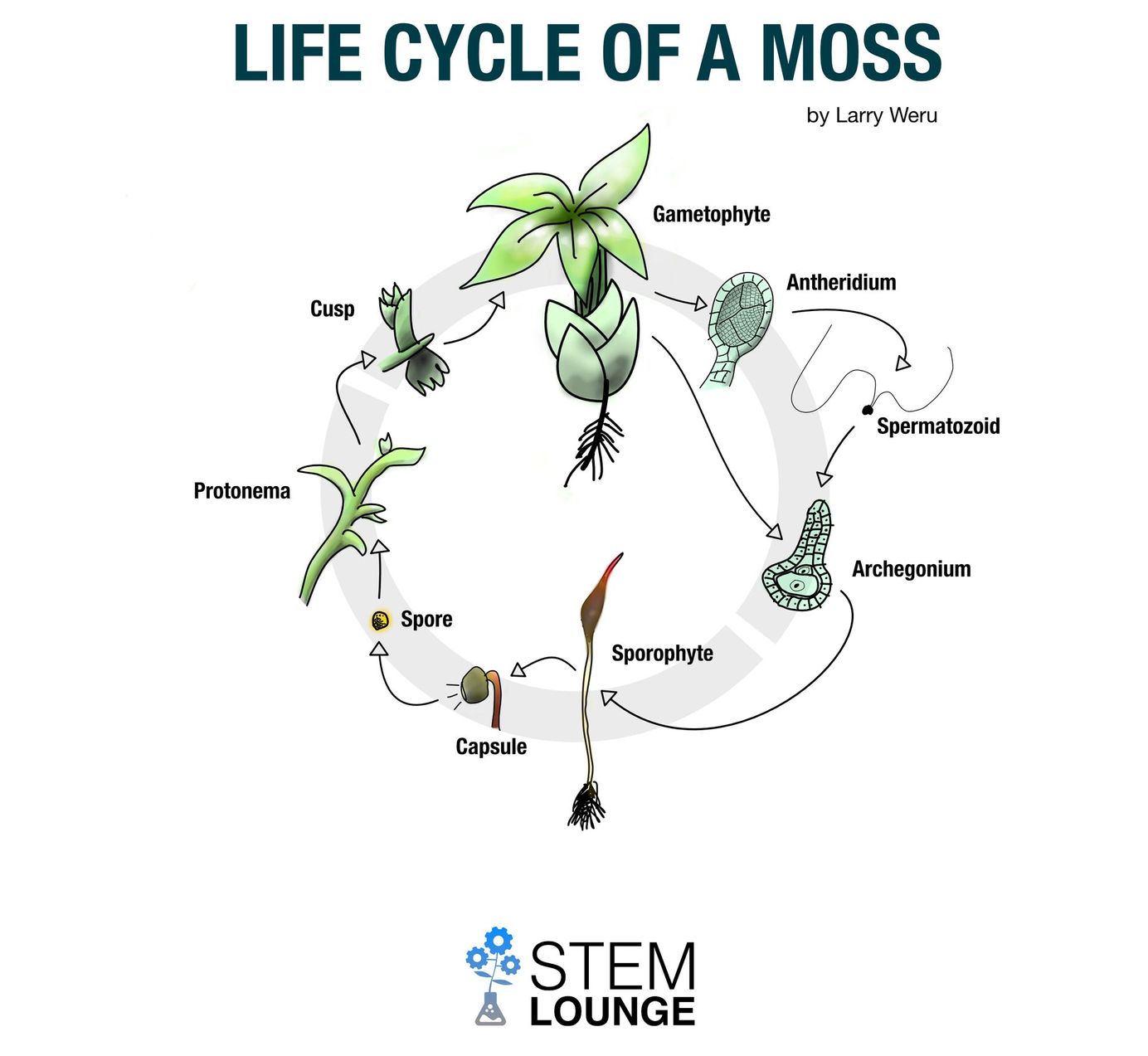Life Cycle of a Moss - Infographic
Mosses alternate between diploid and haploid generations in their life cycle, which is unique among flowering plants. Where does fertilization take place in the moss life cycle? Scroll to the Key Takeaways to get the answer, or start from the top to learn about the moss life cycle.

Mosses alternate between diploid and haploid generations in their life cycle, which is unique among flowering plants. Where does fertilization take place in the moss life cycle? Are spores haploid or diploid? Scroll to the Key Takeaways to get the answers, or start from the top to learn about the moss life cycle.
MOSS REPRODUCTION
How does a moss reproduce?
-
Mosses have two forms of reproduction: sexual reproduction and asexual/ vegetative reproduction. This is true for all bryophytes.
-
Practically all flowering plants are diploid, but for mosses, this is different. Mosses alternate between diploid generations (as sporophytes) and haploid generations (as gametophytes).
SEXUAL REPRODUCTION
Generally speaking, sexual reproduction is the process where genes from two different parents mix to produce offspring with a genetic makeup similar to, but different from, each parent.
The sexual reproduction of the moss (bryophyte) life cycle alternates between diploid sporophyte and haploid gametophyte phases. In a nutshell, haploid gametophytes produce haploid gametes, which can be sperm or eggs. When egg and sperm merge, they form a diploid zygote which grows into a diploid sporophyte. Sporophytes produce haploid spores, containing genetic information from both haploid gametophyte parents. A spore gives rise to a haploid gametophyte, completing the cycle.
Gametophyte
-
A single gametophyte moss plant can produce both sperm and eggs. This can occur on different parts of the same plant, one part producing sperm and another part producing eggs. However, a plant usually produces either all sperm-producing organs or all egg-producing organs at any one time. This way it doesn't breed with itself, promoting genetic variation. The female structure for producing eggs is known as the archegonium, and the male structure for producing sperm is known as the antheridium. Antheridia are tiny, typically stalked, club-shaped or spherical structures. Archegonia are bottle-like containers, their wall just one cell thick. Archegonia are typically formed in groups. Archegonia and antheridia are usually bundled in leaf rosettes similar to flowers, called perichaetia. Elongated club-shaped cell filaments called Paraphyse are sometimes found on the gametophyte, storing water and protecting the archegonia sand antheridia from drying up.
-
When the antheridia are ripe and the flower gets wet from rain, numerous antherozoids (spermatozoids / sperm cells), are released. Antherozoids are only able to move underwater. They swim using two threadlike tails. Some successfully end up on female gametophyte moss plants and are chemically attracted to the archegonium. Each archegonium holds one egg, in a swollen section called the venter. The sperm enter the archegonium through the narrow channel in its neck. Fertilization occurs in the archegonium to form a diploid zygote. Once one archegonium in a group has been fertilized, in many cases the others lose the ability to be fertilized. This is caused by an inhibitory hormone released from the fertilized archegonium.
-
The formation of the zygote begins the second phase of the moss life cycle, where the zygote develops into a diploid sporophyte (spore-plant).
Sporophyte
Upside-down photo of moss after rain. Sporophytes got their hands in the air like they just don’t care. https://t.co/jDpYaHweHn pic.twitter.com/tFeU2ahzgO
— Megan Lynch (@may_gun) March 18, 2020
-
After fertilization, the archegonium on the gametophyte plant becomes modified into a protective sheath around the young sporophyte. The sporophyte begins to grow by mitosis (diploid cell division) out of the top of the archegonium. It elongates and after a few cell divisions begins differentiation. At this point the sporophyte is practically a parasite on the gametophyte plant, although it may produce some food of its own via photosynthesis in the early stages of growth.
-
The embryonic sporophyte consists of three structures: a foot, seta, and a capsule. The foot, on the lower portion, anchors the sporophyte to the gametophyte via penetration and helps to transfer water and nutrients from the gametophyte. The seta is a long erect supporting stalk. At the end of the sporophyte is a pod-like capsule where spores are produced. The seta only occurs in species where the mature capsule is stalked.
-
Transfer cells develop at the sporophyte-gametophyte boundary in the majority of bryophytes, but not all. These specialized cells allow efficient transfer of nutrients from the gametophyte to the sporophyte. They may form on the gametophyte, sporophyte, or both. The gametophyte-sporophyte junction is often convoluted and maze-like. This increases the surface area, allowing for more transfer cells than a simple boundary, thus increasing the rate at which nutrients can flow to the sporophyte.
-
A capsule may contain four to over a million spores, depending on the species. It also may be stalked or stalkless depending on the species. In most mosses, the mouth of the capsule is covered by a lid-like operculum, which falls off when the spores are mature. A membranous hood, the calyptra, which is also discarded at maturity, further protects the operculum.
-
In wet conditions the spores can't travel very far. A tiny tooth-like structure around the mouth of the capsule controls the release of the spores. These structures, called the peristome, consist of one or two rows of teeth. They prevent the release of the spores during wet conditions by remaining closed. In dry conditions they open, releasing the spores.
-
Each spore contains a mix of genes from the two parents. If the spore falls onto a damp area of ground, it may germinate into a branching, threadlike filamentous protonema. Cusps bud from the protonema then grow into leafy male or female gametophytes, completing the life cycle.
ASEXUAL REPRODUCTION
-
In addition to sexual reproduction, mosses can reproduce asexually (vegetatively). The method they use to accomplish this depends on the situation they're in.
-
When the stem of a large clump of moss dies back, the stem-less clump becomes individual plants.
-
When bits of the stem or even a single leaf from the moss plant are broken off, these bits can then regenerate to form a new plant.
KEY TAKEAWAYS
- In the moss life cycle, fertilization takes place in the





